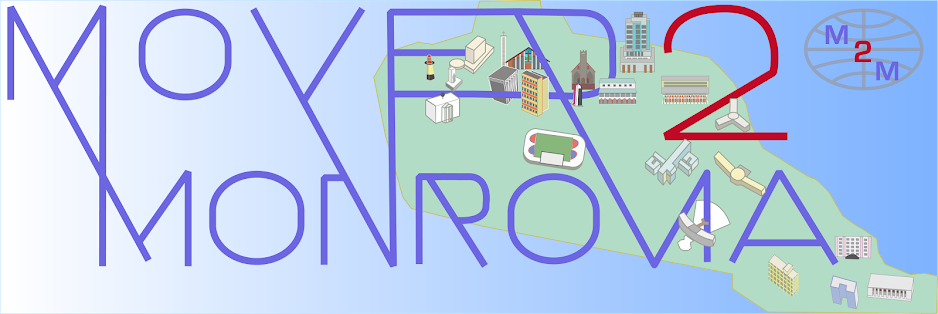To-day, businessmen and investors from all parts of the world have discovered the commercial and industrial potential that is the Wealth of Liberia"
Big thanks to
Twitter bud Chris Carnel for immediately alerting me to this YouTube posting from
Pepperbird Studios: a restoration of a c.1974 newsreel on Liberia, released to Yor-El Francis of Pepperbird from the Tolbert family's private collection.
Every once in a while a vintage film or photo surfaces which embodies this blog better than a thousand word post. This grainy, colorful, 22-minute archival gem seems tailor-made for this blog, starting off with a Swissair DC-8 landing at Robertsfield, and from there launching right into a sightseeing tour of the landmark buildings of central Monrovia, most of them barely 10 years old at the time. It almost recalls this blog's Architectural Tour of third of a century later.

Monrovia reflected in a graceful cultural heritage, but a city, as modern as To-day... Buildings steeped in the traditions of Liberia's rich history...Building reflecting the country's promise of a rich future. As with the imposing Executive Mansion, home of the country's president, William R. Tolbert...Buildings that reflect the civic dignity of the city, its commerce and industry... For the well-being of its people, the JF Kennedy Memorial Hospital..The renown Ducor Intercontinental Hotel also looks out to one of the islands first sighted by those early settlers, 150 years ago.

Its a glowing overview of the Camelot that was Late Classic Liberia wonder-story, the High-Tolbertian boom of Rally Time, raw commodity exporting, rapid industrialization, all narrated in an infallibly clipped mid-Atlantic accent, blaring trumpets heralding the excitement of an economy on the move in between the frenetic reporting. Act One is made up of several minutes of luscious street scenes of bustling mid-1970s Monrovia, looking spotless and state-of-the-art: leafy Broad Street lined with fine-looking buildings, all recognizable today.


There's current no information about who the customers for the film-making were, but presumably this was a governmental commission, although the Tolbert family's
now-somewhat infamous Mesurado Group of Companies features more than prominently throughout the feature, almost to the point where the film becomes indistinguishable as a promotion of the conglomerate or of the country itself. In those days, as in other times, investing in the Liberian economy meant investing in, or at least closely alongside, prominent and elite families.


That contentious issue aside, the film spends a good deal of time noting many of the government programs aimed at assisting the general population, in skills training, employment and the advancement of agriculture through higher education twinned with research and development. Tobacco, processed crepe and latex rubber, cocoa, coffee and timber seem to pour out of the Liberian hinterlands and through the humming, orderly ports of Buchanan, Greenville, Harper, and of course the Freeport. It's undeniably impressive.
There are also some delightful scenes of Swissair's glass-fronted ticket office in the Palm Hotel, at the corner of Broad and Randall Streets, as well as the busy Air Liberia office, whose location was presumably on Broad Street as well, but this is a new one for me. Later in the film, the Wings of the Pepperbird are shown linking the bustling port of Buchanan and to the industrial hive of Mount Nimba to Spriggs Payne.
The entire film is quite astonishing. In its economic overview, a sequence of scenes breeze through factories and finishing lines for cigarettes and soap, paint and packaged seafood, window frames and wood products, none of which exist 39 year later. Only Cemenco is recognizeable, although the legacy of Parker Paint and others live on in place names. Likewise lost to war and history are the refining capacity of the Liberia Petroleum Refining Company.
Outside of the industrial zones, the Agricultural educational farms decentralized in Virginia, Lofa, and Grand Bassa, as well as the Liberia Feed Mill Company, provide a quasi-statal architecture of agricultural advancement, with a goal of not only building export volumes, but becoming self-sufficient in rice production. The Liberia Produce Marketing Corporation, like so many of these ventures, has since ceased to exist. Even these structures and facilities have disappeared.
In contrast, the gleaming towers of commerce, culture and industry are all recognizable, standing today either as shabby shadows of their former selves, albeit serving the exact same purpose as they did originally (the Masonic Temple, Chase Manhattan Plaza, Centennial Pavilion, the Executive Pavilion, the Executive Mansion, Ministry of Education, Ministry of Finance, Monrovia City Hall, JFK Hospital) or standing as shameful shells of once-boastful monuments, like the E.J. Roye Building and the Ducor Hotel.
Indeed, the early shot of businessmen arriving at Robertsfield almost exactly matches
the picture on RIA's Wikipedia page: the airport's facility is the same building today as it was in those days.
The entire feature is an amazing gem for Liberiophiles and history buffs. It's entirely preciously-rare footage of Liberia's golden era, from the sunny scenes of the new Gardnersville and Amical Cabral housing estate to the incredible breadth of Liberia's industrial facilities. Of course, the film is painfully bittersweet, as it speaks of the Wealth of the Future and Progress, barely five years before President Tolbert was assassinated in the Executive Mansion, the opening violence in a horror which erased every inch of Liberia's progress, much of which, astoundingly, has yet to return.



























































